- For the Rovolution picking robot, which has won multiple awards, TGW relies on condition monitoring
- The Digital Twin as a central innovation in the age of Industry 4.0
(Marchtrenk, Austria, 19th April 2021) In the course of Industry 4.0 development, monitoring the condition of important components should eliminate the need to bring material handling systems to a standstill. The trick is to optimise system availability continuously, says Dr Maximilian Beinhofer, Head of Cognitive Systems Development at the intralogistics specialist TGW.
What are the drawbacks if maintenance work is not carried out until a component stops working?
Dr Beinhofer: That approach is known as corrective maintenance. This can entail a machine or system – or parts of it – coming to a standstill. This means that availability is reduced, which may put the user at a disadvantage economically. Another problem is that some cases require troubleshooting to find the fault in the first place. This takes precious time.
As an alternative, you can simply replace wear parts at regular intervals.
Yes, this is called preventive maintenance. The idea is that specific maintenance or replacement cycles are defined based on empirically established data. This guarantees very high system availability. The drawback is that costs are higher because some parts get replaced when they could still be used for a while longer. The crux of the matter is finding the ideal moment – both for the provider and for the customer of maintenance services. Therefore, condition monitoring and predictive maintenance provide a good solution. Based on something called "digital twins", this solution is considered one of the central innovations in the area of Industry 4.0.
How does predictive maintenance work?
Using sensors to monitor the condition of components, you can run a software simulation to see whether a problem is coming up. This is ideally done in real time or with only minimal delay. The gist of our approach is as follows: Using smart algorithms – that is, methods from the area of machine learning and data science – we at TGW take data that have already been provided by sensors and link or merge these data in an intelligent way that allows us to make very precise statements about the condition or wear of components. This saves expenses because we don't have to install additional sensors.
Can you name an actual example?
In our award-winning Rovolution picking robot, we measure the status of the vacuum in the gripping device. If there is a pressure loss, for example due to the dust load of the environment, we can see that immediately and respond.

What do you do with older systems that are not equipped with the necessary sensors?
There is the option of installing additional sensors – to measure vibrations, for instance. Depending on the size of the system, the number of sensors required may range between just a few and several hundred. For this reason, a cost-benefit analysis should definitely be run beforehand. But in general it is true that retrofitting existing material handling systems is possible.
What is the difference between predictive and prescriptive maintenance?
The two approaches build upon each other. You need condition monitoring as a basis for predictive maintenance. Here, knowing whether a sensor is occupied is not enough. You have to know the extent of the wear. If these data are available, you can use predictive maintenance software to forecast that a component that has reached a specific value will last for approximately another three months, for instance. Prescriptive maintenance will then advise you on exactly what steps to take in three months.
What are the main benefits of predictive maintenance?
The point is, generally speaking, to optimise system availability while keeping costs low. In addition, the feedback loop improves continuously. Algorithms ensure that the self-learning system will optimise itself continuously.
In which areas does predictive maintenance make sense?
Generally, anywhere within a system. However, the linking elements are of greatest interest. For instance, if one out of ten picking workstations fails, ninety percent of the capacity is still available. But if a sorting system fails, and all articles pass through this system, then this failure leads to an immediate standstill.
What are the challenges of predictive maintenance?
One challenge is to create maximum leverage with minimum effort. Another challenge – a technological one – is to use the networks of the system in such a way that the data required for the predictive maintenance software can be transmitted. The feedback loops are the third challenge. If problems occur in the conveyor system, the on-site technicians must report them. As a manufacturer, you have to develop intelligent methods so that feedback is both output immediately and suitable for automated evaluation.
How do you guarantee this?
If you want to be able to train the algorithms, you have to know exactly when a maintenance task was performed and what exactly it consisted of. Otherwise, the system will believe that an improvement has come about on its own. But this report must not consist of text freely written by the technician. It must consist of standardised responses from a drop-down menu because you need machine-readable data if you want to be able to train the machine learning system. At the same time, the feedback loop has to be operated quickly and easily so that the maintenance technician can provide the feedback swiftly.
For which modules does TGW develop predictive maintenance?
Condition monitoring is already available for the Rovolution picking robot. At the same time, we are developing a specific cloud solution for data acquisition and processing. The idea is that all data – from mechatronics to IT – are to be recorded in future. Of course, this process will comply with the GDPR and data security. We record the data of multiple customers. This comes with the advantage that a new customer will benefit from the data of existing customers and receive advice from the software on what to do in order to optimise their system.
The digital twin is the outcome of this process. You can either use the replay mode to analyse what has happened or you can view in real time what is happening right now. An additional step allows you to look into the future and make predictions.

How will demand for solutions from the area of predictive maintenance develop?
The topic is popular right now. I assume that within five or ten years all systems sold will provide this service. Even now, it has become standard that large individual machines are equipped with a vibration sensor. In material handling systems interlinked over a large geographical area, various strategies are still in use.
Do customers see the benefit, and are they willing to pay for such services?
I believe that in the long term, the business models behind maintenance contracts will change. The new tools and services offer advantages for customers – and these advantages will ultimately be visible in the Total Cost of Ownership (TCO). Accordingly, we will also adapt our business models.
Mr Beinhofer, thank you for the interview!




